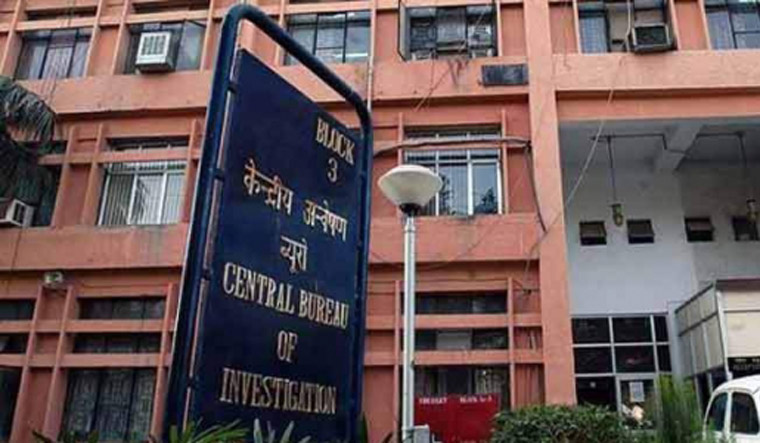Should the CBI be blamed for acquittal of all the accused in the Babri Masjid demolition case? This will be the question haunting the premier federal investigating agency for the time to come as it failed to prove its case in the special CBI court in Lucknow, which delivered its verdict in the Babri Masjid demolition case on Wednesday.
It is not the first time the agency has miserably failed to prove its case against top politicians in a high-profile case. The list is long—the 2G scam case came to naught after trial while the Bofors bribery case did not even reach the stage of trial.
But as far as the present case is concerned, the CBI investigators are not ready to take the entire blame for acquittal of all the accused in the case. The CBI has got a copy of the judgement and will be studying it before deciding on its future course of action. The CBI spokesperson did not respond to queries related to the judgement.
But CBI sleuths involved in the decades-long case had seen the writing on the wall. “The trial went on for over quarter of a century; 16 out of 48 accused died while the trial was still pending. Some witnesses lost interest in the trial. Some of the witnesses even became incapable of giving evidence in the court,” said a CBI investigator who was associated with the probe of the case.
CBI officials involved in the probe said that it becomes difficult to trace witnesses in such a long trial. For example, the original video cassettes (of the incident) were to be screened in the open court in presence of the witnesses who recorded it. Tracing the witnesses and requesting them to come to the court was a big task. “Some witnesses turned hostile. We do not have a witness protection law in the country. Changed political scenario also leads to silence in many quarters,” said an official.
The Babri Masjid was demolished on December 6, 1992, leading to riots in many parts of the country in which thousands of people were killed.
The country’s financial capital, Mumbai, was terrorised by serial blasts in 1993, allegedly at the behest of most-wanted accused Dawood Ibrahim and Pakistani intelligence agency ISI. By all accounts, it was a watershed incident in the history of the country, leading to deep-rooted social and political divisions.
The first case with regard to the demolition was registered in the local police station against lakhs of unknown karsevaks.
Investigators recalled that after 10 minutes, another case was registered at the same police station against eight leaders of the BJP and other Hindutva groups for shouting provocative slogans from the Ramkatha Kunj Manch, encouraging the karsevaks who were demolishing the structure. During the demolition process, the mediapersons who were taking photographs and videographing the incident were beaten up by the karsevaks and on such complaints by 47 mediapersons, 47 separate FIRs were registered and thus, in total, 49 FIRs on the same incident in the complex stood registered.
The agency took up investigation of the first and main case on December 13, 1992. Subsequently, on August 25, 1993, all the other 48 cases were also transferred to the CBI and accordingly, it re-registered 48 cases two days later.
Former CBI joint director M. Narayanan was one of the leading investigators of the case. It was a challenging case as when the CBI team reached Ayodhya, at the site, there was nothing except a makeshift temple and rubble all around. Narayanan along with inspector Jogendra Nayak and inspector Hari Singh contacted large number of police persons, Muslim residents and collected the video recordings prepared by various TV channels and examined them. In 1990, also some damage had been caused to the structure by karsevaks, said an investigator, adding that there was an attempt to construct a Ram temple at the same place. Investigation disclosed that there was a single general conspiracy to destroy the disputed structure and construct the Ram temple at that place itself without bothering for court orders or waiting for court orders.
The agency’s investigation laid the blame of demolition on L.K. Advani’s rath yatra too, which he took out in October 1990.
“He was detained on the way to Ayodhya but the steam generated by the rath yatra resulted in storming of the structure, by some karsevaks in 1990, leading to some damage to the structure and in the police firing, some karsevaks also died,’’ said an investigator.
“Our investigation also found Bajrang Dal, VHP, Shiv Sena, BJP and RJB Nyas trained selected karsevaks for the demolition purpose. A decision was taken by the Margdarshak Mandal in the meeting held in Ujjain in May 1992 that karseva should be done and just like Babur did not fix a date for demolition of the temple and construction of a masjid at that place, Hindutva groups will also not give a date for demolition of the masjid and construction of Ram temple at that place, and hindrances in the way of construction of Ram temple will be removed,” said an investigator of the case.
Investigation further revealed that the Margadarshak Mandal held a meeting in Delhi in the end of October 1992, where it was decided that karseva will begin for construction of Ram temple on December 6, 1992.
CBI’s charge-sheet stated that in the meeting of Shiv Sena held at New Delhi on October 30 and November 1, 1992, it was decided that the structure at Ayodhya will be demolished and Shiv Sena will do a different karseva.
According to the CBI, the Bajrang Dal’s main convener said that a special squad had been formed and kept at 25km range to do the job quietly. Subsequently, the VHP leaders made different speeches and implements were purchased.
Some VHP leaders told TV channels that they had selected 800 karsevaks. Shiv Sena leaders visited Ayodhya on November 28 and said that the structure will be demolished on December 6, said an officer, recalling that there were many such statements by leaders.
Advani started his yatra to Ayodhya from Varanasi and Joshi from Mathura and on the way, they made many statements and mobilised huge gatherings.
On December 6, the leaders were seated on the Manch nearby and made provocative speeches and raised slogans, said the CBI.
According to the investigators, when some leaders were told that the karsevaks are falling from the dome and getting injured, they asked them to get down and told them that security forces are coming and they should block the roads.
‘’Nobody told them to spare the domes. In fact, there were many statements to the contrary made by many VHP and Bajrang Dal leaders,’’ said an official.
Investigators recalled that it was a challenging job to collect evidence. “About 10 lakh people were present at Ayodhya and Faizabad. Whoever was present there was a karsevak. They did not want to speak. Those injured karsevaks in the hospital in Ayodhya and Faizabad were angry with us when we asked questions and threatened us. Witnesses were the mediapersons, both print media and electronic media, and the police officers, but they were busy in their work. Few gave the facts,” said an investigator in the case.
Armed with the aforementioned evidence and after legal scrutiny and legal opinion, the CBI filed a charge-sheet against 40 people for the criminal conspiracy and the demolition and hurting religious sentiments. On further investigation, charge-sheet against eight more people was filed, resulting in a total of 48 accused in the case. Of these, 22 were charged for dacoity also.
The trial court, after hearing both sides and perusing the evidence on record, passed a detailed order on September 9, 1997, and framed charges against all the 48 accused persons. Against the order, 33 accused went to the High Court and the court on February 12, 2001, passed an order that in 48 cases the order is correct and in crime number 198/92, known as the Manch case (against top political leaders sitting on the Manch during karseva), the notification entrusting the case to the Lucknow court was not valid. The court also stated that the notification can be corrected.
The CBI did not move the Supreme Court against the High Court order but a special leave petition, or SLP, was filed by a private person in the top court and the SC in November 2002 held that the crime no. 198/92 is a different case and the case is to be tried at the Rae Bareli court where it was pending.
“Thus the conspiracy case was to be tried at two different places. Accordingly, complying with the Supreme Court order, the CBI filed an application in the Rae Bareli court to take appropriate action. The said court finally ordered the CBI to file supplementary charge-sheet in crime No. 198/92. The CBI filed a supplementary charge-sheet against the same accused as charge-sheeted in that case by the CB/CID, in the Rae Bareli court on May 31, 2003,” explained a CBI official.
Now on the basis of the High Court order declaring the notification as invalid, the Lucknow special judge passed an order two months later, holding that both cases are different and in the Manch case 198/92, it dropped proceedings against the leaders.
The CBI then wrote to the Uttar Pradesh government to rectify the defect in the notification but they refused to do so. The CBI filed a revision petition in the High Court and nine years later, the High Court said both structure and the Manch are two different places and there are two categories of accused—the demolishers and the other leaders on the Manch who encouraged them. Against this order, the CBI filed a special leave petition in the Supreme Court in 2011 and the court in April, 2017, using the constitutional power, reversed and modified its order of 2002 and ordered that all the accused should be tried in the Lucknow special court together.
All the 48 accused in the Babri Masjid demolition case:
1) Pawan Kumar Pandey
2) Brij Bhushan Singh
3) Jai Bhagwan Goyal
4) Sakhshi Maharaj
5) Vinod Kumar Vatsa (deceased)
6) Ram Chandra Khatri
7) Sudhir Kakkar
8) Aman Nath Goyal
9) Santosh Dubey
10) Prakash Sharma
11) Jai Bhan Singh Paweya
12) Dharmendra Singh Gurjar
13) Ram Narayan Das (deceased)
14) Ramji Gupta
15)Lallu Singh
16) Om Prakash Pandey
17) Lakshi Narayan Das Mahatyagi (deceased)
18) Vinay Kumar Rai
19) Kamlesh Tripathi
20) Gandhi Yadav
21) Hargovind Singh (deceased)
22) Vijay Bahadur Singh
23) Naveen Bhai Shukla
24) Ramesh Pratap Singh (deceased)
25) Acharya Dharmandra Dev
26) Ravindra Nath Srivastava
27) Devendra Bhadur Rai (deceased)
28) Ashok Singhal (deceased)
29) Giriraj Kishore (deceased)
30 Lal Krishna Advani
31) Murli Manohar Joshi
32) Vishnu Hari Dalmiya (deceased)
33) Vinay Katiyar
34) Umar Bharti
35) Sadhvi Ritambara
36) Moreshwar Save (deceased)
37) Mahant Avaidyanath (deceased)
38) Ram Vilas Vedanti
39) Dharam Das
40) Mahant Nritya Gopal Das
41) Mahatmandeleshwar Jagdish Muni Maharaj (deceased)
42) Balkunth Lal Sharma (deceased)
43) Paramhans Ram Chandra Das (deceased)
44) Satish Kumar Nagar (deceased)
45) Bal Thackeray (deceased)
46) Kalyan Singh
47) Satish Pradan
48) Champat Rai






